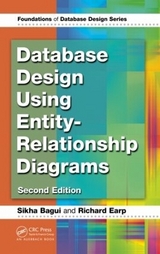
Database Design Using Entity-Relationship Diagrams
Auerbach (Verlag)
978-0-8493-1548-0 (ISBN)
- Titel erscheint in neuer Auflage
- Artikel merken
Entity-relationship (E-R) diagrams are time-tested models for database development well-known for their usefulness in mapping out clear database designs. Also commonly known is how difficult it is to master them. With this comprehensive guide, database designers and developers can quickly learn all the ins and outs of E-R diagramming to become expert database designers. Because E-R diagrams are so fundamental to database design, this book is also an indispensable text for teaching computer science students the basics of database development.
Database Design Using Entity-Relationship Diagrams clarifies E-R diagramming by defining it in terms of requirements (end user requests) and specifications (designer feedback to those requests). The book explains how open communication between designers and end users is critical to developing usable, easy-to-understand E-R diagrams that model both requirements and specifications.
The authors explain, in an intuitive, informal manner, how to develop an E-R diagram, how to map it to a database, and how the resulting database can be tested. This definitive guide is a basic component for any database course, and is also an invaluable reference that database professionals can use throughout their careers.
introbul>Features
The Software Engineering Process and Relational Databases
What is data and what is a database?
What is the software engineering process?
ER Diagrams and the Software Engineering Life Cycle
Data Models
The Hierarchical Model
The Network Model
The Relational Model
Functional Dependencies - this section will be expanded significantly
Summary of Chapter
Exercises for Chapter 1
References
Normal Forms
First Normal Form
Second Normal Form
Third Normal Form
Examples of lNF, 2NF and 3NF
Example of Non lNF to lNF
Example of Non 2NF to 2NF
Example of Non 3NF to 3NF
Summary of Chapter
Exercises for Chapter 1
References
The Basic ER Diagram - A Data Modeling Schema
What is a data modeling schema?
Defining the database - some definitions: entity, relationship, attribute
A Beginning Methodology
ER Design Methodology
A First "Entity only" ER Diagram
More about Attributes
The Simple or Atomic Attribute
The Composite Attribute
The Multi-valued Attribute
The Derived attribute
The Keys
English Description of the Entity
The Method
Mapping the Entity Diagram to a Relational Database
Summary of Chapter
Exercises for Chapter 3
References
Case Study
Beyond the First Entity Diagram
Examining an Entity - Changing An Attribute to be an entity
Defining a relationship for our new entity
A Preliminary Grammar for the ER diagrams
Defining a Second Entity
Does a Relationship Exist?
Attribute or relationship?
Summary of Chapter
Exercises for Chapter 4
References
Case Study
Extending Relationships/Structural Constraints
The Cardinality Ratio of a Relationship
Participation - Full/Partial
English Descriptions
Tighter English
Some examples of other relationships
One Final Example
Mapping Relationships to a Relational Database
Summary of Chapter
Exercises for Chapter 5
References
Case Study
The Weak Entity
Strong and Weak Entities
Weak Entities and Structural Constraints
Weak Entities and the Identifying Owner
Another example or a Weak entity and the identifying owner
Weak Entities connected to other Weak Entities
Revisiting the Methodology
Weak Entity Grammar
Mapping Weak Entities to a relational database
Summary of Chapter
Exercises for Chapter 6
Reference
Case Study
Further Extensions for ER Diagrams with Binary Relationships
Attributes of Relationships
Relationships developing into Entities: The M:N Relationship Revisited
More Entities and Relationships
More Evolution of the Database
Attributes That Evolve into Entities
Recursive Relationships
Multiple Relations
The Derived or Redundant Relation
An alternative ER Notation for specifying Structural Constraints on Relationships
Review of the Methodology
Mapping rules for Recursive Relationships
Summary of Chapter
Exercises for Chapter 7
References
Case Study
Ternary and Higher Order ER Diagrams
Binary or Ternary Relationship?
Ternary Relationships and Structural Constraints
n-ary Relations do not preclude binary relations
Methodology and Grammar for the n-ary Relationship
Ternary Relationships from relationship-relationship situations
n-ary Relationships May be Resolved into Binary Relationships
Mapping to ternary diagrams to a relational database
Summary of Chapter
Exercises for Chapter 8
References
Generalizations and Specializations
What is a Generalization or Specialization?
A Problem with Variants
Example of a Generalization/Specialization
Methodology and Grammar in Generalization/Specialization relationships
Mapping rules for EER Diagrams
Summary of Chapter
Exercises for Chapter 9
References
Case Study
Relational Mapping and Reverse Engineering ER Diagrams
Steps used to map an ER diagram to a Relational Database
Reverse Engineering
Examples of Reverse Engineering
Summary of Chapter
References
Exercises for Chapter 10
A Brief Overview of the Barker/Oracle-like Model
A First "Entity only" ER Diagram - An Entity with Attributes
Attributes in the Barker/Oracle-like model
Relationships in the Barker/Oracle-like model
Structural constraints in the Barker/Oracle-like model
Dealing with the concept of the weak entity in the Barker/Oracle-like model
Dealing with the concept of multivalued attributes in the Barker/Oracle-like model
Treatment of Foreign keys
Recursive relationships in the Barker/Oracle-like model
Mapping M:N relations
Summary of Chapter
Exercises for Chapter 11
References
Glossary
Index
| Erscheint lt. Verlag | 27.6.2003 |
|---|---|
| Reihe/Serie | Foundations of Database Design |
| Zusatzinfo | 76 Tables, black and white; 111 Illustrations, black and white |
| Verlagsort | London |
| Sprache | englisch |
| Maße | 178 x 254 mm |
| Gewicht | 658 g |
| Themenwelt | Mathematik / Informatik ► Informatik ► Datenbanken |
| Mathematik / Informatik ► Informatik ► Theorie / Studium | |
| ISBN-10 | 0-8493-1548-4 / 0849315484 |
| ISBN-13 | 978-0-8493-1548-0 / 9780849315480 |
| Zustand | Neuware |
| Informationen gemäß Produktsicherheitsverordnung (GPSR) | |
| Haben Sie eine Frage zum Produkt? |
aus dem Bereich



